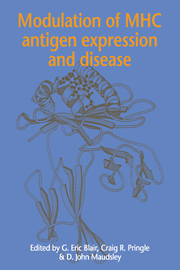Book contents
- Frontmatter
- Contents
- List of contributors
- Preface
- List of abbreviations
- 1 General introduction to the MHC
- 2 Organization of the MHC
- 3 Interactions of cytokines in the regulation of MHC class I and class II antigen expression
- 4 Control of MHC class I gene expression
- 5 Control of MHC class II gene expression
- 6 Modulation of MHC antigen expression by viruses
- 7 Modulation of MHC antigen expression by retroviruses
- 8 Modulation of MHC class I antigen expression in adenovirus infection and transformation
- 9 MHC expression in HPV-associated cervical cancer
- 10 Inhibition of the cellular response to interferon by hepatitis B virus polymerase
- 11 Cellular adhesion molecules and MHC antigens in cells infected with Epstein-Barr virus: implications for immune recognition
- 12 Effect of human cytomegalovirus infection on the expression of MHC class I antigens and adhesion molecules: potential role in immune evasion and immunopathology
- 13 Oncogenes and MHC class I expression
- 14 Mechanisms of tumour cell killing and the role of MHC antigens in experimental model systems
- 15 Manipulation of MHC antigens by gene transfection and cytokine stimulation: a possible approach for pre-selection of suitable patients for cytokine therapy
- 16 Overexpression of MHC proteins in pancreatic islets: a link between cytokines, viruses, the breach of tolerance and insulindependent diabetes mellitus?
- 17 The role of cytokines in contributing to MHC antigen expression in rheumatoid arthritis
- 18 Expression of an MHC antigen in the central nervous system: an animal model for demyelinating diseases
- Index
14 - Mechanisms of tumour cell killing and the role of MHC antigens in experimental model systems
Published online by Cambridge University Press: 11 September 2009
- Frontmatter
- Contents
- List of contributors
- Preface
- List of abbreviations
- 1 General introduction to the MHC
- 2 Organization of the MHC
- 3 Interactions of cytokines in the regulation of MHC class I and class II antigen expression
- 4 Control of MHC class I gene expression
- 5 Control of MHC class II gene expression
- 6 Modulation of MHC antigen expression by viruses
- 7 Modulation of MHC antigen expression by retroviruses
- 8 Modulation of MHC class I antigen expression in adenovirus infection and transformation
- 9 MHC expression in HPV-associated cervical cancer
- 10 Inhibition of the cellular response to interferon by hepatitis B virus polymerase
- 11 Cellular adhesion molecules and MHC antigens in cells infected with Epstein-Barr virus: implications for immune recognition
- 12 Effect of human cytomegalovirus infection on the expression of MHC class I antigens and adhesion molecules: potential role in immune evasion and immunopathology
- 13 Oncogenes and MHC class I expression
- 14 Mechanisms of tumour cell killing and the role of MHC antigens in experimental model systems
- 15 Manipulation of MHC antigens by gene transfection and cytokine stimulation: a possible approach for pre-selection of suitable patients for cytokine therapy
- 16 Overexpression of MHC proteins in pancreatic islets: a link between cytokines, viruses, the breach of tolerance and insulindependent diabetes mellitus?
- 17 The role of cytokines in contributing to MHC antigen expression in rheumatoid arthritis
- 18 Expression of an MHC antigen in the central nervous system: an animal model for demyelinating diseases
- Index
Summary
Introduction
Even before 1975, when the role of the MHC antigens as a ‘guidance mechanism’ for the immune system was discovered (Zinkernagel & Doherty, 1975), it was known that some tumour cells expressed abnormally low levels of MHC antigens and/or β2-m (Nilsson, Evsin & Welsh, 1974). In addition, there was ample experimental evidence that tumour cells could be ‘recognized’ and eliminated by the immune system, although early work had failed to take into account allogeneic recognition of transplantation antigens (Foley, 1953). By the 1950s it had been clearly shown that chemically induced, radiation-induced and spontaneously occurring tumours could express tumour antigens that could initiate and lead to ‘tumour rejection’, namely the tumour-associated transplantation antigens, TATAs (Gross, 1943). It was only in the late 1970s or early 1980s that these two strands of research could be put together and they have subsequently led to important advances in the clinical treatment of cancer.
These advances are related to the great insight of Paul Ehrlich, who postulated that the immune system acted as a surveillance system to detect changes within the body caused either by normal pathological events or by invading organisms (Ehrlich, 1909). It is now clear that the primary function of CTLs is to monitor cell surfaces for abnormal peptides presented by MHC class I antigens. T cells reactive to normal self peptides will have been made tolerant either by clonal deletion or clonal anergy.
- Type
- Chapter
- Information
- Modulation of MHC Antigen Expression and Disease , pp. 315 - 334Publisher: Cambridge University PressPrint publication year: 1995



